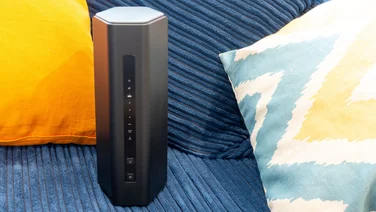To help us provide you with free impartial advice, we may earn a commission if you buy through links on our site. Learn more

- Clever features
- Good speeds at close range
- App is quite basic
- Slightly overpriced
- Slower performance over distance
We’re now at the point where if you want absolutely stable Wi-Fi, you need to have a mesh system. With so many models on the market, it’s hard for companies to distinguish their products, but TP-Link has managed to achieve this with the Deco P7, which has built-in Powerline networking.
As good as mesh systems are, the speed of the network is only as good as the quality of the link between satellite devices. For this reason, many mesh systems support an Ethernet backhaul – that is, satellite devices are connected together using a physical Ethernet cable, improving performance. If you don’t have or can’t run Ethernet, things can get tricky, which is where the Deco P7’s Powerline networking helps, using your home’s electrical wiring to transmit data.
Cleverly, the system uses a combination of 600Mbit/s HomePlug AV Powerline and dual-band 802.11ac Wi-Fi (867Mbit/s 5GHz and 400Mbit/s 2.4GHz) to give you the best performance throughout your home.
The Deco P7 is available in a two-pack option, which we tested, or as a three-pack. The former should do for most UK homes, but if you’ve got particularly thick walls, three floors or a very large house, the three-pack is the best option.
TP-Link Deco P7 review: Setup and configuration
The Deco P7 satellites are all identical, with dual Gigabit Ethernet ports on them. The smartphone app (for iOS and Android) takes you through configuration and setup for the system. You start by plugging in one satellite. TP-Link recommends removing your original router and plugging the satellite directly into your modem via the Ethernet port.
This leaves just one Ethernet port spare for other devices, so you’ll probably need to buy another switch.
If you can’t replace your main router, the Deco P7 connects to your existing network instead. This makes some tasks, such as port forwarding, a little trickier, but it won’t bother the vast majority of people.

There is an option to run the Deco P7 in Access Point mode, where it seamlessly joins your network. However, this disables the advanced features, such as parental controls, so we don’t recommend it.
With the first satellite connected, the setup helps you configure a secure wireless network, letting you enter your own name and password. Following that, the network setup takes you through the painless process of adding more satellites into the mix. We like the way that the app lets you pick a reference floorplan that most closely matches your house, so that you can see where’s best to add satellites.
We placed our first satellite at the front of the house where the broadband comes in; the second one was placed in the middle of the house on the first floor. Both were plugged directly into a wall socket, not extension cables.
As with most mesh systems, the 2.4GHz and 5GHz networks are combined under one name. Band steering directs connecting clients to the best network based on range, performance and client capabilities. TP-Link has also implemented seamless roaming, with the Deco P7 system pushing devices to connect to the satellite with the best performance. Without this, Wi-Fi devices have a nasty habit of trying to hold on to a signal even as it gets weaker and weaker.

TP-Link Deco P7 review: Features
The configuration of your network is handled by the app, although it can be a little basic. For example, you can’t override the default channels used for the wireless network, only change the network name and password. The app lets you configure port forwarding, however.
TP-Link has included its impressive parental controls. These let you create a profile for everyone in the family, and then filter web traffic by category, set time limits for internet use and block access at bedtime. Profiles let you group devices that a person owns, too, so rules apply even if a child switches between their computer and tablet.
Amazon Alexa support is built in, so you can ask your smart router to dish out your Wi-Fi details and turn the guest network on or off. We love the IFTTT integration, too. Our favourite IFTTT applet is getting the system to send an email when a new device connects: it’s a handy way to keep an eye on security, letting you know if anything unsuspected joins your network.
TP-Link Deco P7 review: Performance
The Deco P7 doesn’t have the highest Wi-Fi or HomePlug specs, but it’s the combination of the two that TP-Link promises will produce the best results. Running our usual throughput tests, we found that the router managed a throughput of 272.5Mbits/s upload and 460.8Mbit/s download at close range.
Moving up one floor, we saw throughputs of 141.9Mbit/s upload and 127.4Mbit/s download. On the top floor, we saw throughputs of 126.0Mbit/s upload and 144.7Mbit/s download. The drop-off over distance was a little disappointing.
With only two satellites we didn’t get improved performance at the rear of the house or in the garden. However, with the second satellite at the back of the kitchen, where most mesh systems can’t reach using wireless, we saw how adding a third satellite could help, with 35Mbit/s in the garden.
TP-Link Deco P7 review: Verdict
If you have a house full of thick walls that a traditional mesh system doesn’t work in, the TP-Link Deco P7 could be your saviour. For everyone else, you need only spend £40 more to get the Netgear Orbi RBK50, which is faster across the board.
| Key specifications | |
|---|---|
| Modem | Gigabit Ethernet |
| Wi-Fi standard | 802.11ac |
| Stated speed | 867Mbit/s (5GHz), 400Mbit/s (2.4GHz), 600Mbit/s (HomePlug) |
| USB ports | USB Type-C (power only) |
| Wall mountable | No |
| Warranty | Two years RTB |
| Price | £250 |







